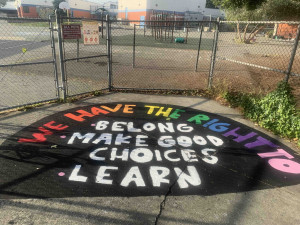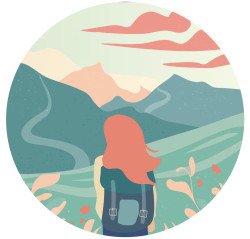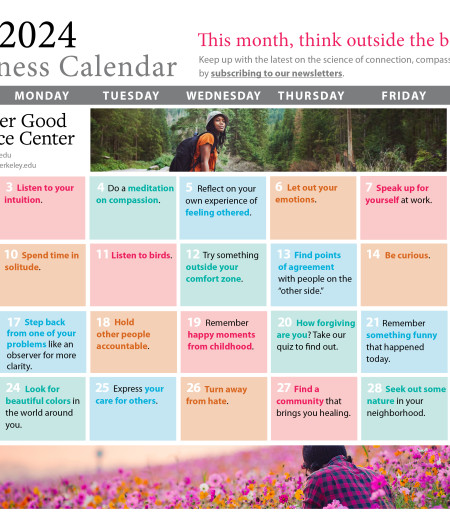How I’m Unlearning White Saviorism

In her book Accidental Saints, Pastor Nadia Bolz-Weber writes, “It can be dangerous when we self-importantly place ourselves above the world, waiting to descend on those below so we can be the ‘blessing’ they’ve been waiting for.” There’s a name for this phenomenon: saviorism.

The author’s daughter’s elementary school in Oakland, CA.
I feel like I’ve spent much of my 44 years on Earth aching to be a simple blessing to others—and continually learning how complex that prospect actually is. Unlearning saviorism has happened for me in what feel like ever more sophisticated seasons of understanding.
Post-college, I had my first humbling. I dragged my hungover friends out of their beds in Brooklyn and made them go to protest the Iraq War on 5th Avenue, sure that the massive turnout would have some real impact. It didn’t. Bush called it a “focus group” and dropped bombs anyway.
I felt outraged, but if I’m being honest, I also felt cheated. I had been raised on “save the world” rhetoric by my well-intentioned teachers and parents throughout the 80s and 90s. I was privileged and white, which means I was conditioned to think that what I did individually deserved gold stars and, well, results. What a reality check the early aughts would prove to be.
I turned my disillusion into fodder for a reporting project—I would travel the country hanging out with other young organizers and activists and see what they could teach me about having a more resilient approach to making the world better. I followed a guy who came of age during the East LA gang wars of the 90s as he schlepped from juvenile hall to juvenile hall to meet with what could have been his little brothers. I learned about the rampant sexual assault within the military and the growing movement, led mostly by women of color, to stop it. I went to gatherings in the Midwest where Black radicals from Detroit and white labor organizers from Appalachia were tentatively coming together over their common cause of environmental justice.
Reorienting my hunger for justice was healing. I became a sober seeker, a collectivist, someone who could be more hearty in the face of setbacks and complexity. I was no longer a daughter of privilege, searching for some transactional and short-term way to “save the world,” or so I thought.
And then I became a mother and, thus, began another season of unlearning. In this one, the sacred cow was not individualism or my entitlement to results; it was the arrogance of my own inner life, where I had set up a default expectation that I was the helper, not the helped.
It was 2013 when my first daughter was born and I was now living in Oakland, birthplace of the Black Panthers and home to a million hipster coffee shops. I enjoyed the camaraderie of other new moms, the kind of women who had midwives and treated breastfeeding as sacrosanct, who would never dress their girls in pink or their boys in blue. We put our babies into little wobbly piles on the couch and took pictures of them leaning into one another, and as they got older, we met up at the farmer’s market and parks to commiserate about how sleepless and anxious we all were.
Then the question of where we would send our children to elementary school emerged and the camaraderie started to crack. I was surprised and confused to find that these radical moms, mostly white or Asian American or biracial, were going to great lengths—strategically and financially—to avoid the Black-majority, Title I school in our neighborhood.
It was poorly rated, sure, but that just mapped onto test scores, not qualitative questions of teaching excellence, sense of belonging, and so many other things I was sure would matter to all of us. The research was unequivocal: When white parents send their kids to integrated schools, all kids do better and white kids do fine—even gaining some additional social skills that serve them later in life. As researcher Rucker C. Johnson puts it, “The medicine that is integration works.”
But despite the convincing research, it turned out, my daughter was the only one from that wobbly pile on the couch who would enroll at our local, Black-majority neighborhood school.

Greater Good Chronicles
A series of essays by people trying to apply the science of a meaningful life to their daily lives.
I didn’t go into that experience with the naive saviorism of my 20s, but I did have high hopes for creating cross-racial friendships with other caregivers and contributing where and how I could to the common life of the school community. Truth is, I was jazzed about being in real relationships with Oakland families of other races, religions, and economic classes. My social group, while racially diverse when compared to average Americans, was also undeniably elite—the kinds of women who use words like “thought leadership” and go to conferences where they get free, fancy water bottles. I liked the idea of being “proximate”—that buzz word of the last decade—to the structural issues facing so many working-class families in Oakland and, therefore, being wiser about what to do about them.
But braided into that excitement was an assumption that my presence would be both welcomed and a boon for the school. It wasn’t, as journalist Nikole Hannah Jones has said, that I thought there was something “magical” about me or my white kid. Sitting next to us wasn’t the boon; our social and actual capital, however, could be. Could be. Pretty quickly, I realized how complicated it all would turn out to be.
My daughter’s Black transition kindergarten teacher, someone whose family had lived in Oakland for many generations, was kind, but seemed standoffish when I tried to relate to her. When she would later leave the school and agree to be interviewed by me for another book project, she immediately made clear that what I saw as integration, she experienced as gentrification. She didn’t love devoting attentional resources to kids like mine when she had really gone into education with the central purpose to center and uplift Black children. Fair enough. We had important, hard conversations about this over the years and created what we both now think of as a noble friendship of sorts.
So my presence wasn’t automatically seen as a “win” for the school—this I learned to wrap my head and heart around by depersonalizing. It wasn’t about me, in particular; it was about what my white skin and the ease with which I could throw money at a problem represented to a community that had long prided itself on Black joy and collective struggle. I kept showing up, assembly after assembly, meeting after meeting, and learned to both move through the school with deep reverence for how my identity didn’t mesh with the beloved history of the place, and also offer up my energy and resources where they seemed supportive.
One of the things I learned pretty quickly was that I could be assured that I was probably acting in solidarity, not saviorism, when I was really listening and hearing answers that surprised me.
Chronic absenteeism is a widespread problem at public schools post-pandemic, and ours is no exception. When I asked our community school manager what she thought might help more of our most marginalized kids show up, I expected to hear about bus passes or alarm clocks. Instead, she suggested a very specific type of hair product that is both pricey and feels critical to a few of the older girls on campus. It is this hair product, she said, that will get even unhoused girls through the school gates on Monday morning. So I bought it and the community school manager distributed it.
But even as I developed the hallmarks of racial stamina—listening rather than assuming, depersonalizing, hanging in for the long haul—I realized that there was still a hierarchy of human value buried deep in my psyche. I still expected to be the one to offer help, not ask for it. I might be offering more gracefully and contextually than before, but I was still the one with something on offer. I might be vulnerable to critique, but I wasn’t vulnerable to my own authentic neediness.
This is where the political became really personal. Simultaneous to all this growing I was doing in this school community, I was also introduced to the Enneagram, a personality typology rooted in colliding ancient traditions, but first popularized by a South American man named Oscar Ichazo. There are nine types, and each one is characterized by different motivations and struggles.
I was skeptical, as so many are, at first, but the new friend who introduced me was a human rights lawyer, the kind of woman who doesn’t suffer fools, so I thought it was worth a look. I typed as a 2—not unsurprisingly, “the helper.” We are most comfortable being in the position of supporting others, but tend to overextend ourselves, growing resentful. We like to show up in the world as selfless, which is only part of the story; we are also dependent on a subconscious arrogance about how effective and altruistic we are. We would rather not get into the messiness of acknowledging our own limits and needs.
Though the science behind the Enneagram continues to be debated, I felt like it was trolling me when I first discovered it, like it had taken the purse of my subconscious, turned it over, and dumped all the contents on a table in the middle of a dinner party. There was stuff in there I knew was in there—the desire to be useful—and there was stuff in there that I hadn’t fully acknowledged for myself yet—the desire to be invulnerable, myself, while magnetizing toward everyone else’s vulnerability.
The work in this season, as I’ve finally come to understand it, is not to stop offering help, but to also start asking for it. By identifying where I need support and relying on my community—my neighbors, other caregivers at our school, my friends—I am slowly dismantling my inner hierarchy. It’s slow going. I’ve spent a long time practicing invulnerability of the superwoman variety and have many solid role models in my family for grinning and bearing all matters of physical and emotional overwhelm.
The other day, my neighbor Jon asked if I wanted him to grab my kids after school when he was picking up his own. My gut instinct was to say no—and then I paused and realized I hadn’t eaten lunch yet, even though it was late in the afternoon, and the extra 20 minutes would allow me to do so. I didn’t need him to pick up the kids, but it would make my life sweeter and easier. I realized that I have this idea in my head that you can only rely on help so many times so you have to save it up for truly tragic circumstances. What a weird notion. I said, “Yes, that would be great.”
I made myself a big, delicious salad. Jon was happy to listen to our kids’ strange chatter on the walk home. I was not a martyr with an empty belly, subconsciously convinced there was a finite amount of help out there; I was a well-fed woman with a wonderful neighbor who sees us as interdependent and love and care as abundant.
My older kid was struggling socially at school. We’d had a million conversations about it over a few months, none of which seemed to have provided much relief to her. During another teary morning, I finally convinced myself it was time to reach out to the principal and her teacher. Before I hit send, I had to battle some old demons—These people are busy. Why would you take up their time with social issues when they’re dealing with kids who have much more severe problems? You can handle it in another way. There must be something else you can try. Of course, it’s important to right-size your own struggles next to others and think about the kind of resources you take up in a community, but I have come to understand this particular voice for what it is—a false friend. She hides behind politics and grit, but really she’s scared of saying, “I need help.” I hit send.
And as I sat in the principal’s office around a table with three other huge-hearted, brilliantly strategic adults who love her—my husband, the principal, and her teacher—I felt this surge of being overwhelmingly blessed. I get to be part of a community where I sometimes help and I am sometimes helped. I get to have useful answers, skills, and resources, and I get to be at a loss sometimes and watch others show up to the table with exactly what I need. Or if not exactly what I need, loving witness, which is always enough, as it turns out.
I’m sure my unlearning is not done, but in this midlife moment, I welcome each new season. These have been both emotional and intellectual evolutions with so many rich frameworks for me to reorient around. I’ve relied on tools as varied as academic disciplines, like intellectual humility, and personality typologies, like the Enneagram. I’ve grown through reading books like My Grandmother’s Hands by Resmaa Menakem and Emotional Justice by Esther Armah, and, more recently, the forthcoming The Right Kind of White by Garrett Bucks and Solidarity by Leah Hunt-Hendrix and Astra Taylor. And I’ve listened along and been transformed by podcasts and movements, like Integrated Schools. In other words, I’m not at all doing it alone.
I don’t want to save others, I want to live and love alongside them. I don’t want to be a savior. I want to be fully human. It’s only in the slow, abundant, vulnerable context of relationship that any of us can escape the hierarchies—outside of us and inside of us—and find real mutuality and freedom from fear of our own inevitable frailty.








